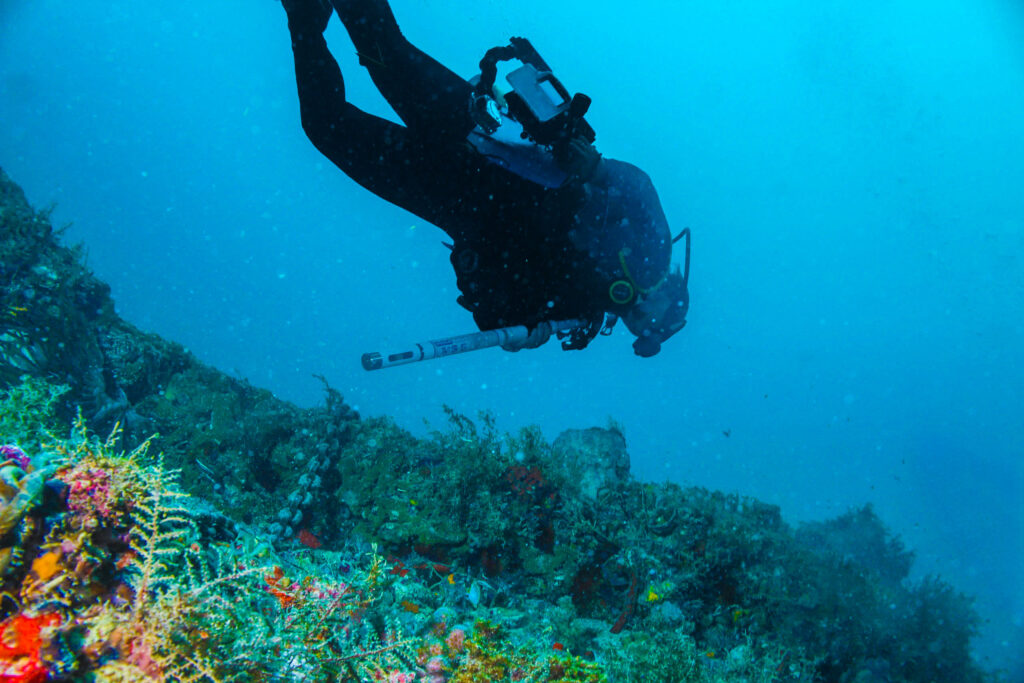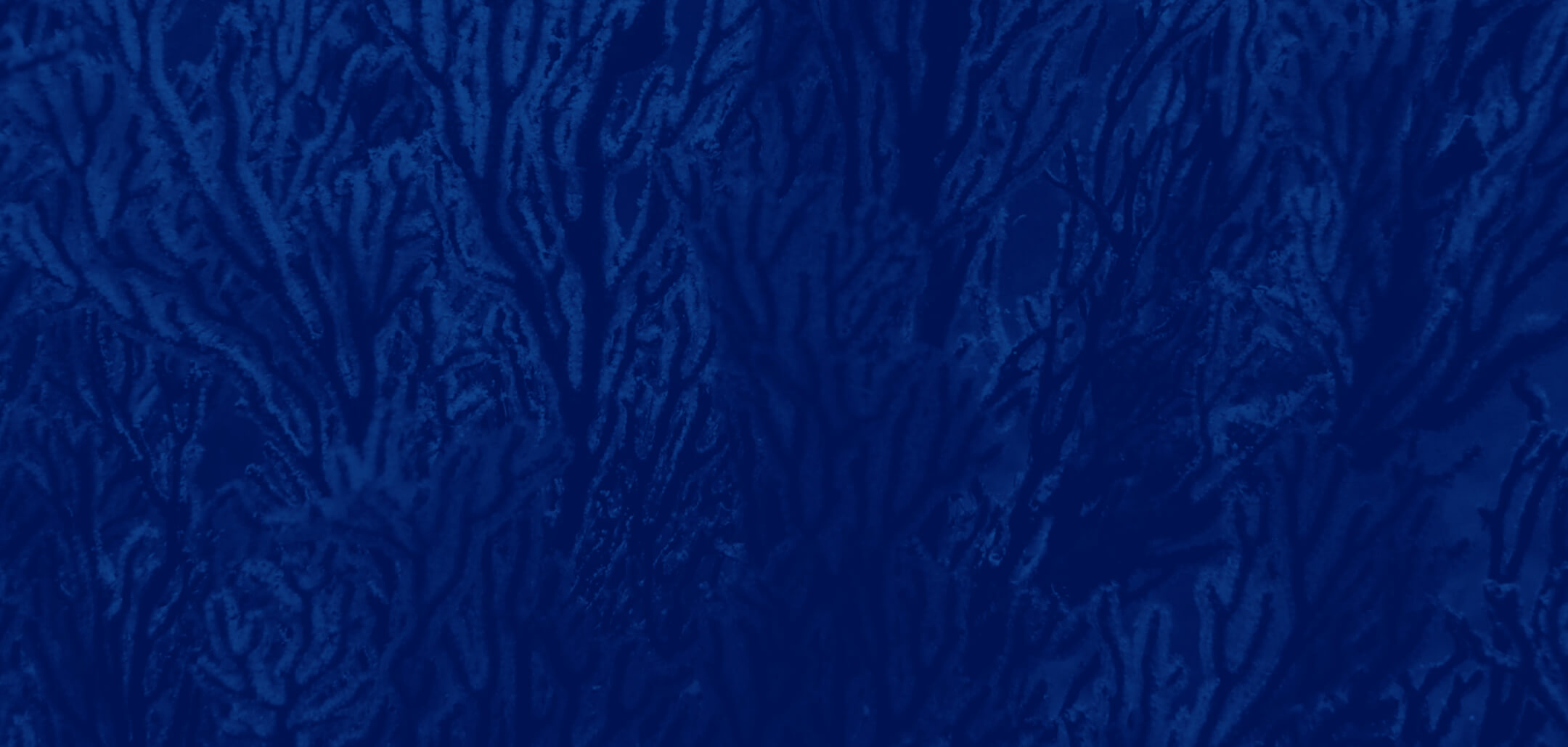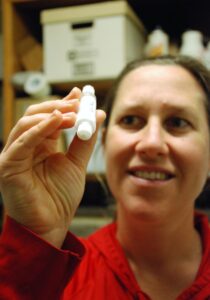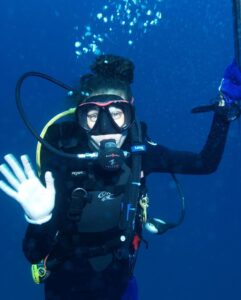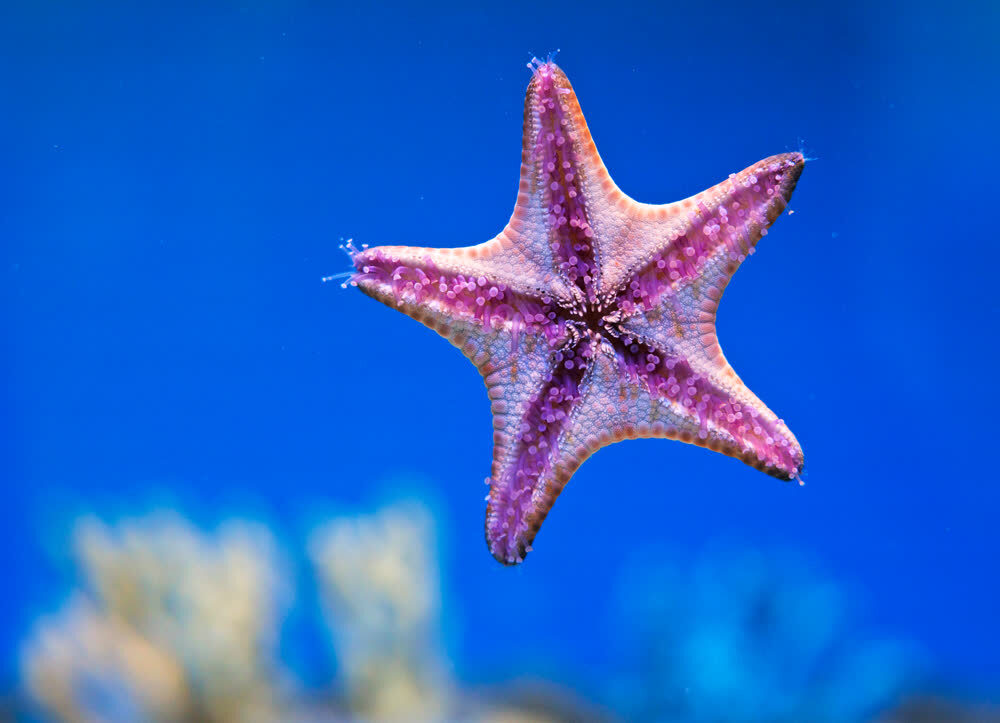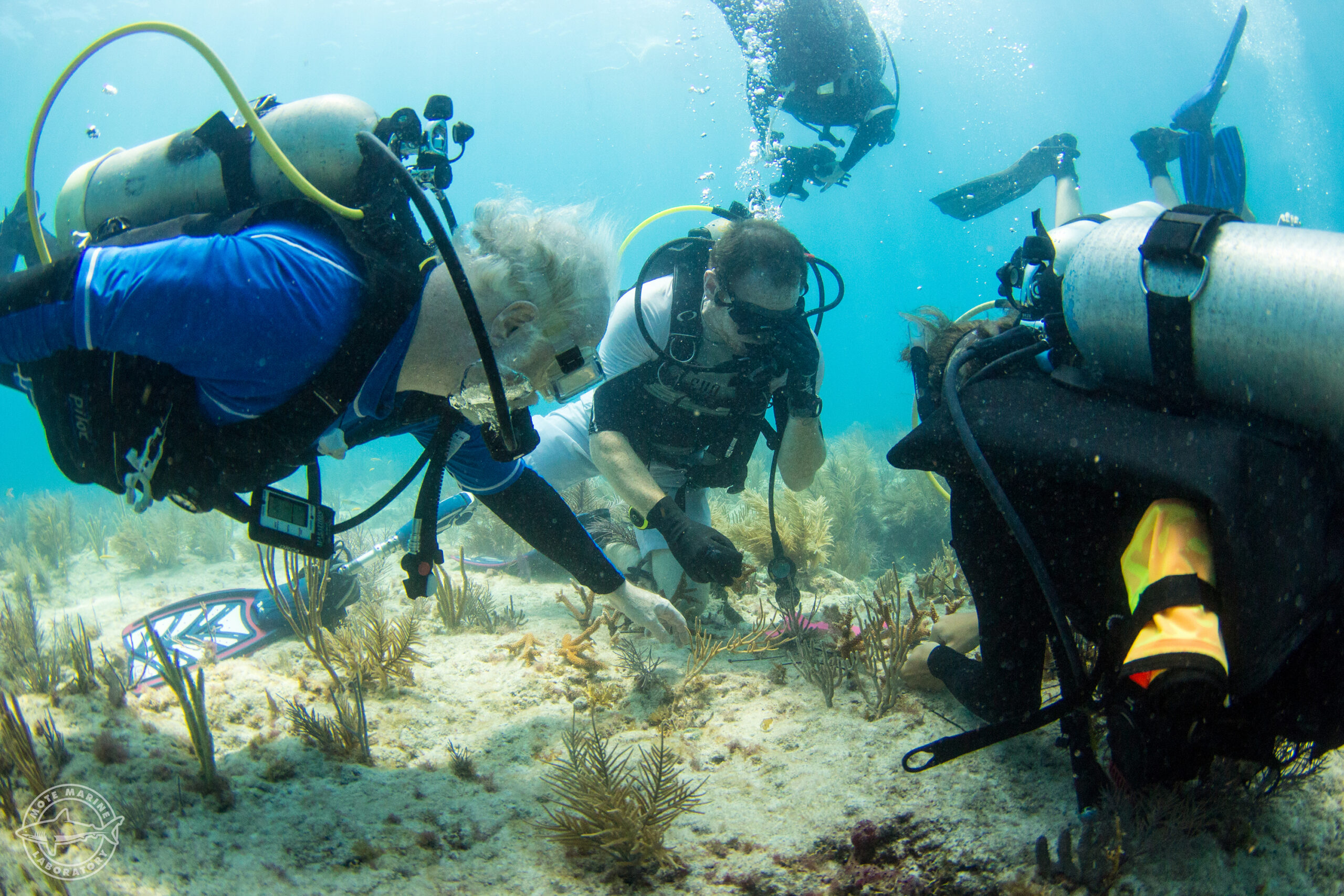Introduction
In September 2020, scientists undertook one of their deepest and most challenging missions yet into the Gulf of Mexico’s blue holes—underwater caves, springs and sinkholes being explored for their unique biology, chemistry and structure.
Dr. Emily Hall of Mote Marine Laboratory is leading the ongoing blue hole study, which took divers 350 feet deep into a site called “Amberjack Hole” earlier this year. Then the team refocused on an even-deeper expedition to the site “Green Banana,” where dives reached deeper than 400 feet. Mote’s Jim Culter pioneered the scientific exploration of the Gulf’s blue holes, working with highly skilled volunteer technical divers, and Culter is joining Hall and others to take the exploration to new levels.
In the current project, Mote scientists are working with Florida Atlantic University’s Harbor Branch Oceanographic Institute, Georgia Institute of Technology, and the U.S. Geological Survey to deploy cool technology—a heavy framework called a benthic lander carrying sensing and sampling gear—into these offshore holes and gather new data on their chemistry, life forms, and other features. Team members want to know how these offshore blue holes might influence the Gulf of Mexico and whether they might even have underground connections to the Floridan Aquifer.
Project partners sincerely thank the National Oceanic and Atmospheric Administration’s Office of Ocean Exploration and Research for the grant that supports this project.
Video from the Mote-led exploration of the blue hole “Green Banana.” Credit: Kristin Paterakis
Green Banana-grams
What’s your name, organization, title and area of expertise? I’m Camia Charniga, I’m a staff chemist for the Chemical & Physical Ecology program at Mote Marine Laboratory
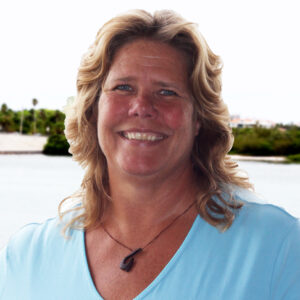
What specific goal(s) or project components did you focus on during the current series of expeditions to Green Banana? How did it go?
I was in charge of deploying continuous recording instruments on the lander and on divers to get an in situ profile of the waters that they were in. I also filtered samples on board ship for later nutrient analyses.
What was your favorite part of the expeditions?
All of it was fun! It’s really exciting to explore new areas and to see the resultant data. It’s hard work to be sure, but also a great feeling of accomplishment.
What was the most difficult part?
Nothing was really “difficult,” but the long days can be challenging in rough seas. Seasickness is a thing, but the work must continue.
Did something cool happen?
Something cool always happens. At the first hole (Amberjack, explored during a past expedition) we discovered two dead sawfish. At the bottom the second, we found some interesting readings on the continuous monitors.
Anything else to add?
I’d do it again in a heartbeat!
What’s your name, organization, title and area of expertise?
Greg Byrd
Mote Marine Laboratory
Captain and DSO (Dive Safety Officer)
What specific goal(s) or project components did you focus on during the current series of expeditions to Green Banana? How did it go?
I was in charge of diver safety and coordinating the deep tech divers.
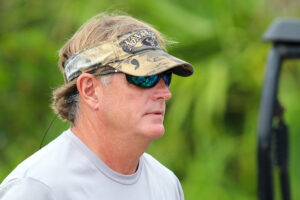
All the diving went very well; we were able to get all the science done without any incidents.
What was your favorite part of the expeditions?
Training to go depths required at Green Banana. It is beyond recreational diving, so Dr. Emily Hall, Cody Cole, and I took some more advanced classes. They were Advanced Nitrox, Decompression Theory, and Helitrox. This was accomplished with the help of TDI and Drew Dye. TDI donated all the classes and certifications for us to accomplish these goals and be able to make the dives safely.
I was also able to take a Closed Circuit Rebreather course. It was great to dive without all the noise from all the bubbles coming from my regulator.
What was the most difficult part?
The preparation of divers and equipment. We all have been planning this expedition for months, and with dives between 160 feet and 400 feet there is a lot that could go wrong. We had two different deep teams to coordinate; this was to make sure no one had to dive to 400 feet two days in a row. This was made possible by all divers getting together on conference calls to go over all the dive plans, and make sure everyone on the same page.
Did something cool happen?
Using my new rebreather and underwater scooter on these dives was great.
Anything else to add?
I cannot wait ‘til spring to go back and do it all over again. With all the hard work that went into this expedition, the reward was worth it. Just want to thank everyone for their hard work and dedication to make this safely happen.
What’s your name, organization, title and area of expertise?
Cody Cole
Mote Marine Laboratory
For this project, I was involved in terms of diving, CTD/rosette (sampling gear) operations, serving as Mate to the Marine Operations Division, and Phytoplankton Ecology
Right photo credit: Kristin Paterakis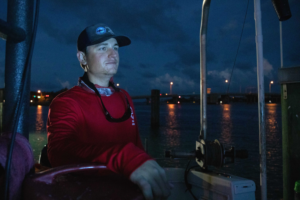
What specific goal(s) or project components did you focus on during the current series of expeditions to Green Banana? How did it go?
For this expedition to Green Banana, I was responsible for three main components: CTD/rosette operation, water sampling, and the rim diving team. (CTD instruments measure conductivity—related to the saltiness of the water—along with temperature and depth.) I operated both the deep water CTD and the rosette during boat-based water sampling, was responsible for getting the data into the right hands post-trip, and also handled any CTD troubleshooting on the fly. I was also on the rim diving team responsible for rim water collection (at the rim of the blue hole, where it opens into the ocean bottom) as well as biological surveys. I also assisted with benthic lander deployment and retrieval topside and filled in other various tasks as needed, such as pre-rigging the daisy chain and figuring out how to mount Niskins (water sampling bottles) to divers, and much, much more!
What was your favorite part of the expeditions?
Definitely the diving. I’ve been diving my whole life but am new to the tech diving world. The training we received in order to make these dives was world-class and allowed us to form new relationships in the diving community. The life down deeper is a completely new world; the fish behave differently as they are not as used to divers, and other life lives at these depths that are less common in shallower water. I’m a way better diver today because of it. I also understand diving science on a whole new level and can now dive deeper, safer, which is very important.
There is a lot of planning that goes into these dives like selecting the correct mixes (of gases), tools, equipment to use, and weighing your options as far as depths and times when planning decompression schedules. Deviations from a plan can greatly vary your decompression obligations, so it is important to know them beforehand. Before these dives, myself and team members all get together and go over our plans and objectives that need to be accomplished. We all agree on a plan before we proceed and also plan for contingencies. Murphy will get you (Murphy’s Law), so plan on the unexpected. During the dives, you have to fully trust yourself, equipment, and other team members. Proper training and lots of practice, to hone your dive skills and keep you sharp, allow you to do just that. Personally during the dives I am task-focused and try to accomplish all objectives while monitoring all equipment and maintaining situational awareness. There is nothing more important than dive safety and I am fully confident in our Mote team; Jim C., Emily, and Greg are all excellent dive partners and I’m proud to be on a team with them. It’s also a ton of fun and I encourage anyone who’s interested to take a leap and go explore all the rich life and beautiful sites the underwater world has to offer. I look forward to continuing my career and advancing in the dive world.
What was the most difficult part?
The most difficult part is long hours and physical demand. No matter how much pre planning goes into this, the plan is always modified on the fly. Some things work great on paper but need to be rethought quickly in the field. This type of work is not easy; it’s a lot of heavy lifting and it can be very dangerous, which is why we have so much training in advance. It takes a dedicated team and trust to execute these types of operations safely.
Did something cool happen?
Yes, no one got hurt. It’s pretty impressive only a few minor bumps and bruises came out of this round, especially with all the risks associated with technical diving—operation of the heavy equipment, heat injuries, and the nature of offshore work.
Anything else to add?
I’m ready for the next round and continuing to dive deep, I’m excited to see results from the science.
What’s your name, organization, title and area of expertise? Dr. Jordon Beckler
Assistant Research Professor
Geochemistry and Geochemical Sensing Lab
FAU Harbor Branch Oceanographic Institute & Institute for Sensing and Embedded Network Systems Engineering (I-SENSE)
What specific goal(s) or project components did you focus on during the current series of expeditions to Green Banana? How did it go?
The goal was to look at the biogeochemistry of Green Banana with a big focus on oxygen and sulfur redox dynamics. (In chemistry, redox dynamics involve transferring electrons between chemical compounds. Redox properties are one of the main natural controls on processes such as nutrient cycling

and the activity of microscopic life, or microbes, in blue holes).
We thought there was water movement in Green Banana based on data that Jim Culter at Mote collected with a thermograph over this past year. So we wondered if Green Banana will be different chemically and microbially from Amberjack Hole (AJ Hole), the site we explored previously, which appears to be very stable in terms of its microbial community and redox dynamics.
Our expedition provided increasing evidence that Green Banana is super different from Amberjack, and it has some sort of water flow. In Amberjack, we detected hydrogen sulfide in the bottom 10 meters of the water column (where oxygen is depleted), and we had oxygen moreso at the top. Where sulfide meets oxygen, you will often find sulfide oxidizing microbes or microbial surface films right at that interface. Indeed, we found a what appears to be a ton of elemental sulfur “gel” right at this interface about 10 meters above the sediments in Amberjack. Now, you go to Green Banana and you have oxygen throughout the entire water column—it’s low but it’s at least detectable. That moves the interface between sulfide and oxygen right down to the bottom, at the sediment-water interface sediments. And indeed, we saw microbial mats on the sediments at Green Banana.
So in Green Banana, we don’t see the super stable sulfidic layer of water that we saw in Amberjack—something seems to be disrupting that. There could be groundwater flow, tidal oscillations, or based on our chlorophyll data, it could even be related to the movement of phytoplankton (tiny plant-like organisms) up and down to access sunlight during the day and nutrients from the bottom at night. It could be a combination, but these dynamics happened like clockwork, within a few minutes of each other a few nights apart!
I think it’s super cool that there appears to be flow of some sort between the greater Gulf of Mexico water column and this blue hole, which appears to be a nutrient rich microenvironment. Moral of the story is, it’s a point source of nutrients offshore. It’s important to understand the implications of that. For instance, can blue holes be one of the nutrient sources for Florida red tide (Karenia brevis) blooms that form offshore?
What was your favorite part of the expeditions?
The real time discovery. We put a new instrument onto our benthic lander (a large framework carrying multiple scientific instruments to the blue hole bottom). It was cool to test out how we want to use our new “toys.” The instrument was a new electrochemical analyzer about the size of an aerosol can, and you could strap it to anything. So on the first dive we strapped it to a diver scooter. On the next dive we strapped it to the benthic lander. This new instrument conducts faster measurements than what we already had on the lander, so we got in situ, autonomous measurements of oxygen, sulfur and thiosulfate, every 15 seconds. That gave us high res profiles of the redox environment, during the 24 hour benthic lander deployment.
What was the most difficult part?
The logistical challenges are super difficult. It’s a long commute to the site, about 55 miles or so offshore, and we don’t have a huge boat. This meant long delays getting samples back on shore and thus late nights!
Did something cool happen?
Looking at the divers’ videos in real time. We watched them on a big screen after our trips each day. We don’t usually have video feedback during the course of our ongoing research, so we are often operating “blind” guided only by the chemistry data our sensors are spitting out.
Anything else to add?
The data was incredible, so that makes me happy.
What’s your name, organization, title and area of expertise?
Dr. Nastassia Patin
Cooperative Institute for Marine and Atmospheric Studies, University of Miami/NOAA
Postdoctoral Associate, microbial ecology and bioinformatics
What specific goal(s) or project components did you focus on during the current series of expeditions to Green Banana? How did it go?My goal was to collect and process samples for microbial DNA extraction, sequencing, and bioinformatic analysis of the microbial communities that inhabit the blue hole. We wanted to understand what microbes regulate the flow of nutrients and energy in the system and how they relate to other marine microbes.
What was your favorite part of the expeditions? My favorite part was meeting all the different members of the team, from chemists to the field technicians to the technical divers, and learning about the passion and skill set each person brought to the project. The training and dedication of the divers was so impressive and it was a thrill to interact with them and learn about their dive protocols!
What was the most difficult part? (This answer focuses on the last blue hole expedition to Amberjack, which is now the subject of research publications.) The most difficult part was incorporating all the different data sets (chemical, biological, and physical) to put together a holistic story of the Amberjack Blue Hole ecosystem.
Did something cool happen? Yes, in Amberjack we discovered an extremely interesting microbial community dominated by a poorly understood Archaeal species at the bottom of the hole. This microbe has very few genes that would be expected from a low-oxygen and high-sulfide adapted organism, and yet it makes up 60% of the community. It opened a scientific question that we hope to answer down the line with additional sampling and experiments. Also, divers found two dead sawfish at the bottom of Amberjack Hole! They had no apparent injuries, and likely swam into the hole together and succumbed to anoxia.
Anything else to add? These expeditions open up a wide new area of research for microbial ecology, biogeochemistry, maybe even paleoclimate research in the Gulf of Mexico. We have only scratched the surface of blue hole life and look forward to learning much more about these systems in the next few years!
What’s your name, organization, title and area of expertise?
Kristin Paterakis
Writer/Producer with South Florida PBS
Dive Professional/Underwater Photographer (freelance)
Communicating science through digital storytelling and technical diving for scientific research
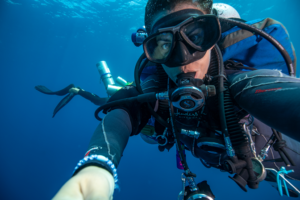
What specific goal(s) or project components did you focus on during the current series of expeditions to Green Banana? How did it go?
My main goal for the project was to support the “shallow” scientific dive team however possible. This included a variety of tasks from collecting water samples, laying out transect tape, and deploying instruments. My second goal was to assist the deep team by transporting bailout tanks and checking in on the deep team during their long decompression stops. We all stepped in where we could in the water and on the boat to make sure everyone was safe and comfortable. My final goal, after all other scientific tasks were complete, was to capture some images of “Green Banana” and the research being conducted to help visually spread awareness to the community on the project.
What was your favorite part of the expeditions?
I was first introduced to the project as I produced an episode on the research for Changing Seas, a marine science and explorations series produced by South Florida PBS. During the production of this episode, I immediately knew I wanted to return to help the team as a volunteer technical diver to help with the research around the rim of Green Banana. For me, one of the greatest parts was to see the evolution of scientific exploration processes from an outsider’s point of view. Seeing the collaboration between an interdisciplinary group of scientists and how they worked with extreme technical divers to make it happen was enlightening. I think I was the only one to dive all five days of the expedition because… well, partially because I was hoping to see a whale shark, but also because I enjoyed learning about each step of the process and wanted to witness the science and the beautiful environment of these exotic ecosystems!
What was the most difficult part?
The most difficult part was having to return to the surface. I think we all wanted to stay down longer and explore the hole even further. It was also difficult to photograph—I think most people imagine all blue holes look like those found in Belize which you can view from the plane. The visibility was so bad that we did not even see the seafloor until we were about 20 feet from the rim. So you won’t see any images of a hole in the water as we descend, and you can’t even tell it is in fact a hole from looking at the photographs taken from at 180 feet and above. I believe this is a sign that it is a highly productive ecosystem, but I’ll let the scientists speak to that.
Did something cool happen?
I think I’ll let the deeper divers and scientists answer that—but the water surrounding the blue hole was full of life. We saw maybe 10 sea turtles over the week, large groups of moon jellyfish and schools of barracuda, dolphins, “waterfalls” of fish, and on the surface we even were visited by an albatross that none of us was confident to say they thought it was an albatross until we got back into cell service and were able to confirm it through a quick Google search!
Anything else to add?
Scientific expeditions like this are not glamorous. It takes a certain level of excitement to explore new environments, even if it’s just a new-to-you environment. I think most of my friends think I am crazy and can’t imagine why I would take my work vacation to go sit on a boat all day to spend an hour diving deep offshore in what they perceive to be a dangerous and dark sinkhole. But I’m already looking forward to the next expedition! I hope this also inspires youth, especially young women, to pursue science and/or technical diving! There is still much to explore on our own planet and we need more young marine scientists and explorers in the world.
What’s your name, organization, title and area of expertise?
Erin Cuyler
Mote Marine Laboratory
Staff Chemist
Ocean acidification and carbonate chemistry
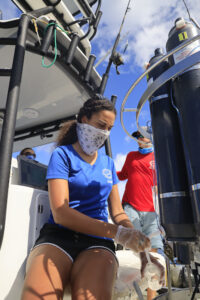
What specific goal(s) or project components did you focus on during the current series of expeditions to Green Banana? How did it go?
My goal for the expedition was to collect samples for carbonate chemistry analysis at stations in and around Green Banana. Water samples were taken at stations that radiated out from the hole in three directions and there were stations every 10 meters from sea surface to the bottom of the hole.
At each station I measured seawater pH using spectrophotometric analysis on board one of Mote’s research vessels, the R/V Eugenie Clark, and collected and preserved samples to take back to the lab and measure total dissolved inorganic carbon (DIC) and total alkalinity (TA). Using the spectrophotometric pH method can provide pH measurements with an accuracy of <0.005 pH units, so it’s a very accurate and precise method if you do it right. All of this data is one part of the water chemistry picture and will help us understand more about the carbon cycle and some of the biological processes going on in the hole. My ultimate goal was to get a good profile of pH, DIC, and TA from the surface to bottom and to use that data to calculate organic alkalinity.
What was your favorite part of the expeditions?
Hanging out on the boat during down times and getting to know all of the new scientists and seeing the familiar ones again. Usually on Day 1 everyone is more tense, but by Day 4 everyone is much closer, joking around with each other and having a great time.
What was the most difficult part?
The early mornings and long days. Our research vessel, the R/V Eugene Clark, left at 6:30 a.m. a couple days, and days were often more than 12 hours long. Also taking seasickness medication which makes me drowsy all day!
Did something cool happen?
On the second day there was a large group, hundreds, of moon jellyfish surrounding us. It was super cool! I jumped in the water and swam with them for a few minutes but had to get out because there was too many and I was worried about getting stung.
Anything else to add?
Overall, it was a successful trip. We obtained all the water samples we were aiming for, all of the diving was successful and safe, and we got some sediment cores and biological surveys as well.
What’s your name, organization, title and area of expertise?
Emily R. Hall, Ph.D.
Mote Marine Laboratory
Staff Scientist
Manager of the Ocean Acidification Program
Manager of the Chemical & Physical Ecology Program
I’m the PI (Principal Investigator) on this blue hole project. My areas of expertise are: effects of ocean acidification and climate change on ecosystems and organisms, carbonate chemistry, and water quality (nutrients and other chemical and physical parameters).
What specific goal(s) or project components did you focus on during the current series of expeditions to Green Banana? How did it go?
Well, as PI, I’m basically in charge of the whole project! That means I’m responsible for the preparation, scheduling, meetings, administration, report writing, safety, training, organization, management, you name it! Aside from all of that, I’m also responsible for collecting water samples for analyses of nutrients, chlorophyll, and carbonate chemistry above the holes and all the way down to the bottom of the holes. My lab runs all of these analyses and then I review and analyze the data to see what kind of a picture the holes are giving us. I am also responsible for making sure the biological surveys are accomplished. I’m ALSO one of the technical divers which means that I have to make sure I’m trained properly, have all of the right equipment for diving AND for sampling, and that I’m being SAFE along with my dive buddies.
What was your favorite part of the expeditions?
That’s a tough one—there are so many great aspects of this project. I really enjoy seeing the plans come together. The diving is AMAZING!!! and I’ve gotten to meet some super cool citizen scientists (our dive team volunteers) throughout this process. Seeing the data and trying to tell a story is also very rewarding!
What was the most difficult part?
Some of the most difficult parts of this expedition were: dealing with weather and trying to keep a large number of people on schedule. We were right in the middle of hurricane season and our mission got pushed back a week, which doesn’t seem like a big deal, but when you have a large team of volunteers and scientists, it can be tricky! Another difficult task is trying to get instruments and sampling gear into a blue hole that’s about 150 feet below the surface, especially when seas aren’t cooperating. But we have such an excellent team and we accomplished our goals!
Did something cool happen?
Everything we did was cool! 😉 Personally, I think the diving is one of the coolest aspects! You get to really see up close and personal what we are studying.
Anything else to add?
I’m just super proud of the team and can’t wait ‘til we see all of the data analyzed and put together to tell the story of these holes!
September 2019: Second Amberjack Hole exploration completed
The second exploration of Amberjack hole was a success! The last time we visited Amberjack hole was during Florida’s dry season. This time we hoped to gain a new perspective by visiting during the summer wet season, and boy did Florida deliver on the wet! Hurricane Dorian came through the first week we proposed to explore Amberjack hole, so the trip was postponed. Then, some impending thunder storms and rough seas poised to postpone the trip again. Luckily, the rough seas subsided, and we were able to get out on the water for our second exploration.
Day 1 was a big day for the Benthic Lander. It was deployed to the bottom of Amberjack hole and programmed to record data and take sediment pore water samples until its recovery the following day. Divers helped lower the instrument down into the hole, and Dr. Jim Culter, a scientist and deep sea technical diver was able to retrieve two sediment cores from the base (350ft down). This is exciting because the data from these sediment cores and benthic lander will be used to study the unique water column and sediment chemistry at the base of these holes.
Day 2 was all about the divers. Divers went down to conduct biological surveys around the rim using GoPro cameras. This footage will later be used to identify species and their abundances and to compare to the biodiversity recorded on the last trip. Divers also retrieved water samples at predetermined “stations” that were collected in transects from the rim outward in three directions. Once the samples were brought on board the scientists went to work, processing the samples for later analyses of nutrients, carbonate chemistry, and phytoplankton and microbial abundances. In addition, Dr. Chris Smith from USGS obtained samples to measure levels of radon and radium.
On Day 3 we obtained a water profile by taking samples from the surface above the hole down to the bottom at 10 meter intervals. This required some serious muscle, as all samples were taken with hand lowered niskins bottles that were attached to ropes. That meant every samples had to be pulled back up manually, even from 350 ft!
What’s next is to analyze all this new chemical and biological data so that we can better understand what’s happening in these systems and how they are impacting the surrounding Gulf waters. Then start looking forward for our next trip in September 2020 to a new blue hole called “Green Banana”.
More updates to come!
Spring-Fall 2019: Amberjack Hole exploration
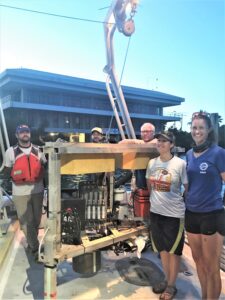
The first exploration of Amberjack Hole has come to an end! It was an incredible experience to work alongside the scientists, divers, and marine operators that made this trip possible.
Looking back, there were definitely some ups and downs; watching the benthic lander sink into the abyss on its way down to Amberjack hole for the first time was definitely a highlight! Hanging over the side of the boat seasick on my first day out at sea definitely was not.
Our planned first trip out to Amberjack hole was Monday, May 13, however, bad weather and high seas forced us to postpone to Tuesday, May 14. But everyone hit the ground running those next two days. Between Tuesday and Wednesday, the benthic lander was deployed and then retrieved, water samples were taken in and around Amberjack Hole and processed for a variety of chemical and biological parameters, and sediment cores and microbial samples were retrieved from inside the hole by divers.
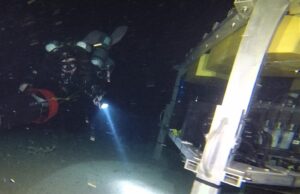
Remember the benthic lander is a giant framework containing many scientific instruments for both sediment and water analysis; it is 5 feet wide, 6 feet tall and weighs over 600 pounds. Moving it anywhere is a feat, but with the collaboration of scientists, deep divers and marine boat operators aboard the research vessel Eugenie Clark, it was deployed off the boat, through the hole’s opening and 350 feet down to the ocean floor!
Research vessels went out an additional two times that week to deploy the benthic lander a second time as well as take some biological surveys of the diverse marine life. Data from the biological surveys, especially of any endangered or commercially important species, will be given to the appropriate agencies and may provide evidence for the need for future conservation of these areas.
In the coming months the labs at Mote Marine Laboratory, Florida Atlantic University, Georgia Institute of Technology, and U.S Geological Survey will work on processing all the abundant data obtained this week and use it to start to create a picture of these unique Gulf of Mexico Ecosystems.
Photos:
Top: The exploration team with the benthic lander before the fall AJ Hole Expedition (credit: Mote Marine Laboratory)
Bottom: Diver with the benthic lander inside AJ Hole (credit: AJ Gonzales)
May 8, 2019: Preparing for our deep dive into Florida’s blue holes

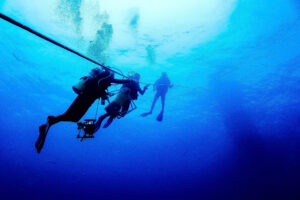
In just a few days, Mote Marine Laboratory scientists will set out on a week’s worth of research cruises to explore a unique, scarcely studied, underwater landscape on the West Florida Shelf — one whose impact on the Gulf has yet to be characterized but is likely very important — Florida’s blue holes.
Most of us have heard of sinkholes on land, but did you know that sinkholes also exist in the ocean floor? Underwater sinkholes, springs and caverns are “karst” (calcium carbonate rock) features that are scattered across Florida’s shelf floor; they vary in size, shape and depth, but most are ecological “hot spots,” oases in the relatively barren seafloor.
If you are lucky enough to dive down to one of these blue holes, you will see a diverse biological community of marine species swimming around you and spread out across the sea floor. Then as you swim away from the rim of the blue hole, the seafloor will evolve from a coral landscape with sponges, mollusks and other benthic (bottom) dwellers to a seagrass meadow. As you get farther and farther away, the seagrass will give way to a relatively barren sea floor.
These blue holes are clearly supporting communities of marine fauna and flora, so it’s important and downright fascinating to understand why — what these unique areas have to offer that sustain these populations. That is one of question that sparked the interest of a small group of scientists at Mote Marine Laboratory, Georgia Institute of Technology, Florida Atlantic University, and the U.S. Geological Survey.
Part of the reason blue holes have evaded regular scientific exploration is their location. The opening of a blue hole can be hundreds of feet down, where only very experienced technical divers can reach, and the openings are often too narrow for automated submersibles. In fact, most reports of blue holes have come from fishermen and sport divers, not from scientists or research cruises.
However, that’s all about to change as Mote gears up for this interdisciplinary exploration of one blue hole, named “Amberjack hole” after one of the fishes found above these habitats frequently.
Some exploratory questions the researchers intend to answer are:
Are these submersed sinkholes connected to Florida’s ground water? Is there potential for groundwater intrusion into the Gulf or saltwater intrusion into Florida’s groundwater?
Is there any reason to suspect a particular bluehole is secreting nutrients and thus affecting primary production? (“Primary producers” are life forms that use sunlight energy to build nutritious, complex carbon molecules and other compounds consumed by different living things in the ocean’s food web.)
Do microenvironments harbor unique or new species of microbes? (Microbes include bacteria and other microscopic life.)
Is the site likely to become a protected area?
They will use an array of scientific methods and instruments to answer these questions, including a “benthic lander,” a large, multipurpose instrument that will be lowered by scientific divers to the base of Amberjack hole and will measure pore water nutrients and fluxes of various chemicals across the sediment-water interface.
Chemical signatures, radon and radium isotopes, will help scientists investigate whether there is fresh water from the Florida Aquifer making its way out into the Gulf through Amberjack hole. If blue holes are connected to groundwater through pathways underneath the continental shelf, then these shelf features could be a point source of land-based nutrients to the Gulf and a newly discovered source of primary productivity; and conversely, there could be potential for seawater intrusion up into the ground water with storm surges and sea level rise.
A second component of the exploration will include benthic surveys, during which divers will swim around and record the sea life present at the rim of the blue hole and above the hole in the open pelagic zone. The abundance and diversity of some species, especially protected species like whale sharks, sea turtles and commercially important fishes, will be documented and given to appropriate agencies. If there is enough abundance and biodiversity of life in these habitats, they may be considered for marine protection.
More blog posts will follow, outlining this exciting research and the scientists aboard the RV Clark as the exploration gets under way.

